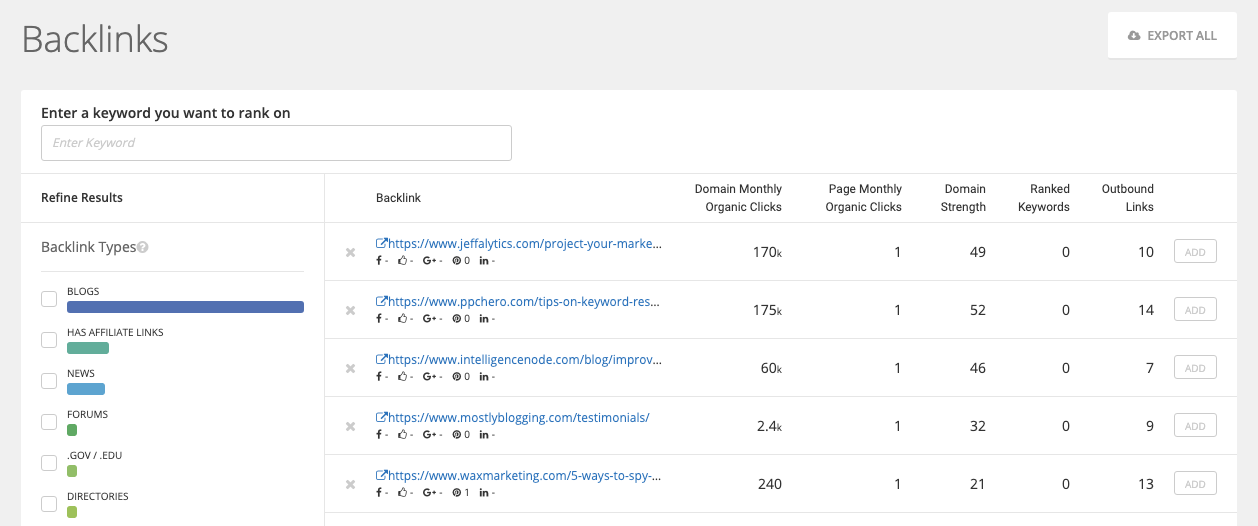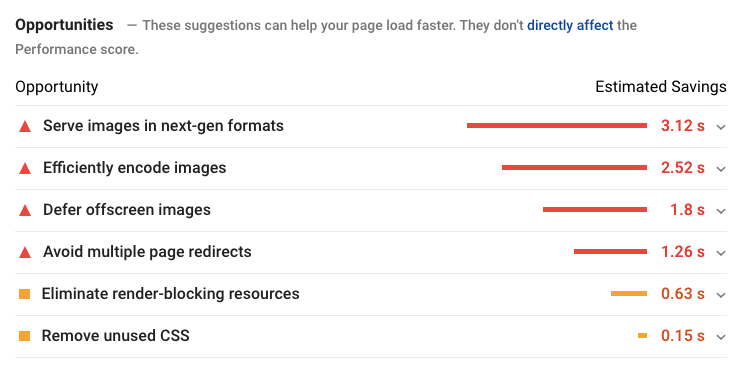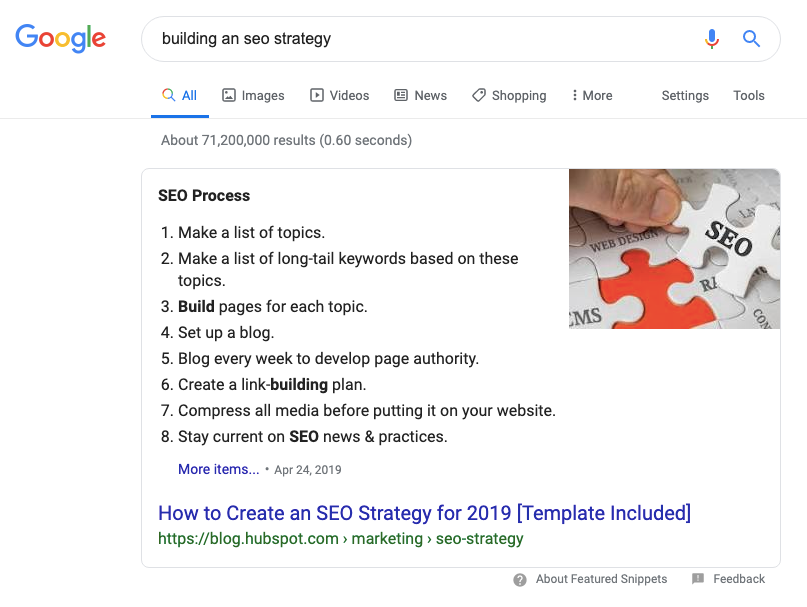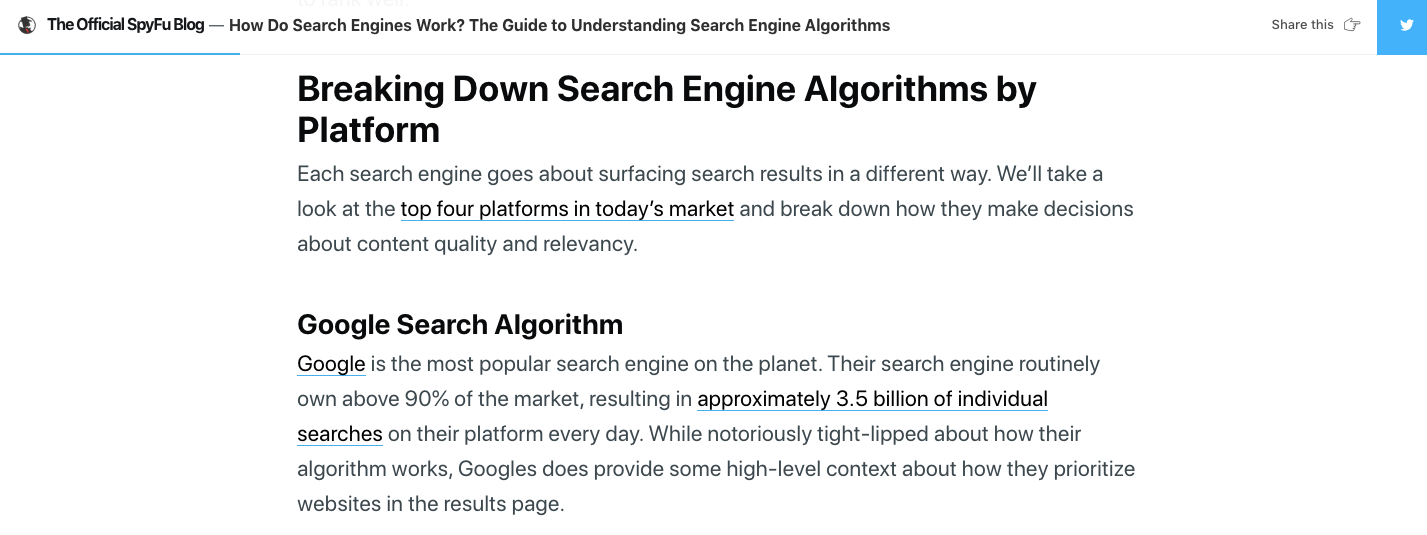We like the idea of setting goals at any point in the year. There's no specific month to start fresh. You choose. It’s exciting to think about the strategies you’ll use, the steps it will take to get there, and the fun new content you’ll create. But first, make all of those come together with well-defined SEO goals.
A set of specific and actionable SEO goals gives you all the guidance you’ll ever need to build a strong SEO strategy. Nailing down your goals for year ahead also helps you be more intentional with every decision you make. Each tactic you use or piece of content you create can be measured against one or more of your SEO goals to evaluate their success. Placing these goalposts gives you and your team something to strive for.
But understanding which SEO goals are right for your business can be difficult. There’s a lot to consider at every step of the process.
With that in mind, we’ve put together a list of 10 SEO goals you can adapt to help get the process started. Let’s dive in!
1. Increase Organic Traffic X%
Organic traffic is one of the metrics that can tell you the most about your SEO success. When you boost organic traffic to your website, it not only opens up a larger pool of potential customers but also signals to search engines that your content is valuable. That, in turn, increases your ranking potential.
We left the percentage in this first SEO goal undefined because the goal for your business will be different from our goals or the goals of other readers. To determine the right percentage for your company, take a look at last year’s organic traffic growth:

This helps you gain an understanding of how your blog has performed so far. With that data, you can extrapolate to set a goal that is achievable but still aggressive enough to produce viable results. Here’s an example:
Let’s say you launched your blog over the past year and have grown organic traffic approximately 7% month over month (MoM). Sure, some months were better than others, but you never quite hit 10%. A reasonable goal for MoM traffic growth in the new year would then be 10-20%. That’s aggressive enough to produce real results, but not so far out of the realm of possibility that it feels unachievable.
Previous growth rates aren’t the only thing you need to look at when setting goals for organic traffic growth, either. It’s important to consider your audience size and your competition as well. If you’re already capturing a significant proportion of your audience with current initiatives, then maintaining a steady 5-10% organic traffic growth would be a fine goal.
Same with your competition: don’t expect to make a meaningful impact on your organic traffic goals if there’s an incumbent who owns a considerable share of the market.
Either way, increasing your organic traffic is likely the most important SEO goal you can set for the new year. It can be your guiding light for the rest of the goals we talk through today.
2. Improve Your Backlink Profile
Gaining high-quality backlinks to your website helps boost it’s domain strength as well as your overall ranking potential. When you’re setting this SEO goal, think about not only the number of links you want to gain but from which websites you want to gain them from as well.
Just remember that building backlinks is all about quality—the number of links you have is a great litmus test for the popularity of your content, but fewer, more authoritative links will help you more in the long run. As you’re setting this goal, look for the specific websites you want to gain these backlinks from. From there, you can dig into their content to see what types of content they typically link to and then look for commonalities.
The SpyFu Backlink Builder tool helps you go through this research to target credible sites that currently help similar content rank well in the SERP. You also have control of the pages you’re going after, filtering only those that can provide real value.

Another great strategy to include in this goal is an outline of how you’ll build the relationship with the owner of the website you want to gain links from. Just know that these relationships aren’t built overnight, it’s important to consistently reinforce the value for both parties involved.
When you’re thinking about this goal, it can be helpful to look at which links refer the most inbound traffic as well. That helps you understand not only which URLs are providing authoritative link equity but also which URLs are sending the most traffic.
3. Strengthen Your Domain Authority
Increasing the strength of your domain can have a huge impact on your ranking potential. The more authoritative search engines see your site, the more priority you’ll receive on the SERP. If this is one of your SEO goals for the coming year, the first thing you need to do is dig into what variables go into calculating this score.
The main component of domain authority is directly related to the quality of the content on your site. Basically, the more visitors read, share, and interact with your content, the better your chances of increasing your score. To really make an impact, look at what content is currently bringing in the most valuable traffic. Then, break down why you think it works, and apply those learnings to your content creation strategy.
Search engines also gauge the quality of your site based on the links you have, so increasing your domain strength is a great goal to use in tandem with improving your backlink profile. When you start thinking about the strategies to boost your score, remember that removing any backlinks with low authority will strengthen your domain as well.
This is one of those goals that brings together a number of different aspects of your SEO strategy, so working to make a positive impact on other goals will help move this one forward.
4. Maximize Page Speed
Here’s our first technical SEO goal. When you increase your page speed, it can have a wide-reaching effect on both your ranking potential and your overall website experience. Make sure to think about the back-end site requirements you need to update as you’re thinking about this goal.
The best way to determine what is required to boost your page speed is to use tools like PageSpeed Insights by Google. This site will review your website and provide actionable suggestions you can take to your design and development teams. Working with your team, you can prioritize the changes that will have the most impact with the least amount of work.

Failing to include the requisite subject-matter experts in the goal-setting process could have a negative impact on your ability to achieve this goal effectively.
keep in mind that, depending on what needs to be updated on your site, work to increase page speed could involve some significant restructuring of your content. Doing so will have an impact on the usability and uptime of your website, so any SEO goals you create around this issue will need to factor in the real “work time” required to complete the updates.
5. Diversify Your Traffic-generating Pages
There’s a common problem for lots of companies: they create an awesome piece of content or a really successful landing page that, as it matures, starts bringing in a statistically significant percentage of the whole site’s organic traffic. Not only does this potentially skew the results for goal #1, but it drastically cuts down on your ability to appeal to a wider audience as well.
To put a finer point on it, the more pages on your website that generate traffic, the more potential you have to bring in qualified leads. Consider the differences between a landing page and a blog article. One is hypertargeted at converting specific leads into users or driving sign-ups for your newsletter, and the other focuses on bringing in interested readers for a specific keyword.
As you’re creating a plan of attack for this SEO goal, consider what different types of pages you want to boost the rankings for. There should be a good mix of landing pages, blog articles, and top-level pages on your site. Not only will diversifying your traffic-generating pages bring in more qualified traffic, but boosting additional pages can also make search engines see your page as more authoritative.
Think about what you can refresh, optimize, and prune to balance how incoming traffic interacts with your site.
6. Capture More Featured Snippets
Featured snippets are a double-edged sword. Although going after these SERP features can bump your content up the results page, it can also skim traffic from your site when users find the information they need in the snippet itself. This is a great SEO goal to use for top-of-the-funnel (ToFu) content, but you don’t want to risk losing potential traffic to your conversion-focused pages further down the funnel.
As you’re setting this goal, think about what different types of content you can rank for in these snippets as well. There are specific structures and types of information that perform well in these snippets. A list, for example, is more likely to be featured than a paragraph explaining the steps is.

Many of the goals we’ve talked through in this post can have an impact on featured snippets as well. The more you boost your ranking potential, the more likely search engines will feature your content in one of their various snippets. Think about how you can combine goals together to build a larger, more comprehensive SEO strategy.
7. Decrease Your Bounce Rate
When someone clicks through to your site and leaves quickly, that’s counted as a bounce by most site analytics providers. A high bounce rate will drive down your ranking potential over time because it shows the search engine that your content isn’t relevant to a searcher’s intent.
The strategies you put in place to achieve your goal of decreasing your bounce rate revolve around matching search intent with your content, headline, and meta description. Those three elements of your page are what searchers will see when your results appear in the SERP.

If you’re even a little bit off in terms of relevancy, anyone who lands on your site looking for something specific will immediately turn tail and leave. Take a look at some of the content from our article:

Understanding how different algorithms work is helpful and valuable for the reader when they want to understand how search engines work. If our article focused on something different, like the different types of localized SEO best practices, for example, most searchers would leave the page.Page speed can also be a factor in high bounce rates. When the experience of navigating to your site or attempting to find specific content is poor, visitors won’t stick around. Make sure you understand exactly what is causing your increased bounce rate before moving forward with any changes.To make this goal specific, set a threshold bounce rate percentage you want every page to stay beneath. That will give you a way to measure the success of your goal and track the impact of any initiatives related to this goal.
8. Boost Visitor Time on Page
This SEO goal works in tandem with goal #7. It makes sense that when you decrease bounce rate, time on page should go up. Use both of these goals as an opportunity to think about the on-page structure of your content. The better your information is organized, the easier it will be for readers to parse the value of your content.
crawlers also look at this kind of structure to learn what your site’s all about. So better organization can make it easier for your site to be crawled as well. That’s why optimizing the on-page elements of your blog, landing, and main page content should be a part of this goal.
Making this goal achievable is all about setting a threshold for your time on page as well. That will help you know when to review specific pages that dip below what is acceptable. Increasing on-page time can also be done by creating better, more comprehensive content. We’re not talking about 10K-word skyscraper articles on every topic, but thinking about how your content engages the reader while also educating them on certain topics is important.
9. Convert More Organic Traffic
Once someone lands on your site, what happens? Do they read your content or bounce to look for other options? When you’re thinking about increasing your overall organic traffic, it’s important to think about how to convert that traffic as well.
This SEO goal is the best way to gain an understanding of the conversion potential of your content. In today’s competitive market, it’s not enough to get visitors to your site—you need to wow them once they’re there.
That’s why funnels factor into this goal more than many of the others we’ve talked through today. Part of the process for setting this goal should be an honest evaluation of both your marketing and your conversion funnels. Look for points of failure or times when leads typically drop off. It can be helpful to break down your conversions by specific channels as well.

When you do that, it helps you break down exactly where you need to focus your actions.
Start small with landing pages, then expand your learnings into articles and main site content. This ensures that you’re able to prioritize the content that makes the most impact on your conversion capabilities first, helping you to learn better and move faster.
10. Optimize Your Internal Linking
Internal linking isn’t just useful for keeping visitors on your website longer. It is a positive ranking signal for search engines. As you’re preparing for this goal, think about the two distinct aspects of internal linking—one for website visitors and one for web crawlers.
To appeal to web crawlers, one of the most important things you should do is create a sitemap that’s updated whenever your website changes. Not only will this give web crawlers the information they need to parse the structure of your site faster, but it will also help you visualize how all of your pages link together. This might not seem valuable when you’re just starting out, but once you have hundreds, or thousands, of pages to work with, understanding how it all fits together is vital.
This SEO goal is a good time to think about how your site structure could be improved on the whole. Consider what frameworks, like the hub-and-spoke model you can use to make this linking clearer for actual human readers. This gives you a well-defined process for creating content that’s structured, easy to understand, and elegant.
The more internal linking you have, the easier it is for both web crawlers and potential customers to go deeper into your site as well. As visitors interact with your site, you can provide additional context in the form of new articles or downloads to help your readers achieve their goals. And web crawlers can flow through the links of your site more efficiently; this cuts down on crawl time and potentially increases the speed at which any content you create is indexed and ranked.
Setting the Right SEO Goals Sets You Up to Win
When you create well-defined SEO goals for yourself and your team, it ensures that you’re always moving in the same direction. These goals are your lodestar on a path to better results and can help you prioritize the types of content and strategies that help your company grow.
Don’t do yourself the disservice of setting goals that don’t matter. Think about how each action you take moves your company toward a better, more successful future.

